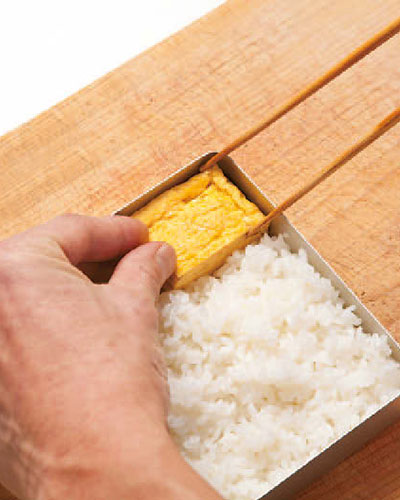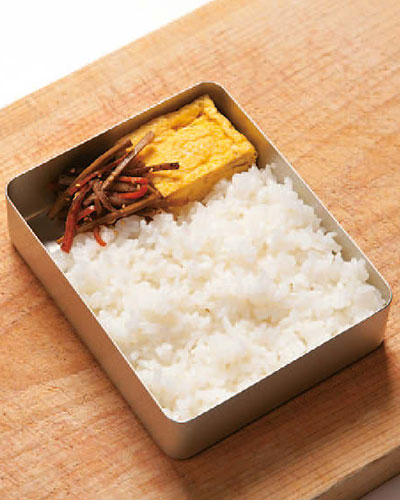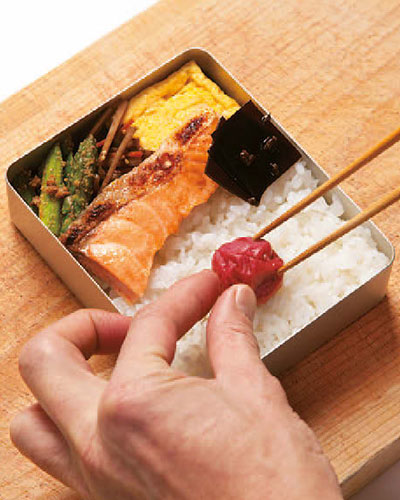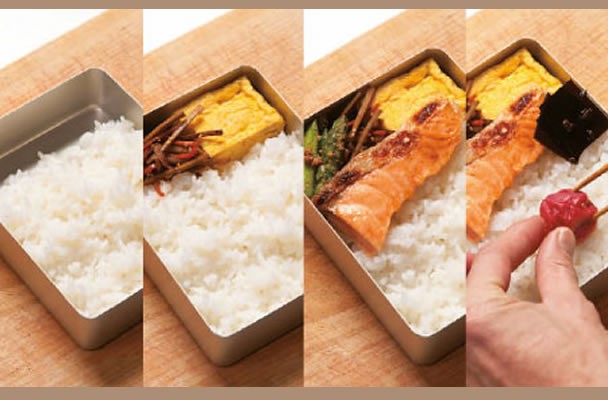
“Bento should not only taste good, but also be enjoyable to eat,” says Kasahara. “The trick is to decide on the main item to feature in the bento and balance that out with a few side dishes.” Here’s a basic guide for assembling the Hinomaru bento, along with general tips for bento-making.
 Masahiro Kasahara
Masahiro KasaharaKasahara, a Tokyo native, trained for nine years at Shogatsuya Kitcho before taking over his family’s yakitori restaurant. In 2004, he opened Sanpi-Ryoron, which soon became one of the hottest eateries in Tokyo. He opened a second location in Nagoya in 2013. Considered a rising star of Japanese cuisine, Kasahara frequently appears on television and other media.
SANPI-RYORON
Ota Bldg. 1F, 2-14-4 Ebisu, Shibuya-ku, Tokyo
Tel. 03-3440-5572
www.sanpi-ryoron.com
 Hot rice is easier to pack,
as it easily fills in
the corners of the
bento box.
Hot rice is easier to pack,
as it easily fills in
the corners of the
bento box.1
Pack the rice into the bento box while it’s still hot. Pile the rice high at the front of the box, but lower toward the back, to allow ample space for the side dishes.
 Place solid, square items in the corners.
Place solid, square items in the corners.2
Place the dashimaki rolled omelet in the upper right-hand corner.
 Foods with flexible
shapes are useful for
filling in gaps.
Foods with flexible
shapes are useful for
filling in gaps.3
Arrange the kinpira gobo (sauteed and simmered burdock) next to the rolled omelet.
 Foods with flexible shapes are useful for filling in gaps.
Foods with flexible shapes are useful for filling in gaps.4
Put the sesamedressed asparagus in the upper left-hand corner. Arranged side by side, these components will fill the empty space at the top of the bento box.
 The main item or colorful
foods should be placed
toward the top or
the center of
the bento
box.
The main item or colorful
foods should be placed
toward the top or
the center of
the bento
box.5
Lay the grilled salmon on top of the rice.
 The overall color palette
will be more appealing
if similar-colored
foods are kept
separate.
The overall color palette
will be more appealing
if similar-colored
foods are kept
separate.6
Add the kombu tsukudani (soysimmered kelp).
 7
7Place the umeboshi on the rice, and your Hinomaru bento is complete!
Creating the perfect bento: the basics
1. Choose lean meat. Fatty meat has less appeal at room temperature.
2. Use vegetable oil for sauteing; butter hardens when it cools.
3. Make sure all heated ingredients have been cooked completely.
4. Bento components should not be too moist. Excess sauce or dressing
can seep into the rice and other dishes, muddying the flavors and detracting
from the bento’s appearance, or even causing spoilage. Runny
foods should be packed in separate containers, or in foil or silicone cups.
5. Blot excess oil and moisture from foods with a paper towel before
packing. This will keep fried items crisp even when they have cooled.
6. Make sure all bento ingredients are cool before closing the box lid.
Condensation can also cause spoiling.
Source『 KATEIGAHO INTERNATIONAL Japan EDITION 2015 Spring / Summer Vol.35 』
Photography by Hoshito Omija
Recipes and preparation by Masahiro Kasahara
Styling and text by Atsuko Sakamoto
Translation by Julie Kuma
Copy editing by Katherine Heins


Comments